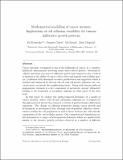Files in this item
Mathematical modelling of cancer invasion : implications of cell adhesion variability for tumour infiltrative growth patterns
Item metadata
| dc.contributor.author | Domschke, Pia | |
| dc.contributor.author | Trucu, Dumitru | |
| dc.contributor.author | Gerisch, Alf | |
| dc.contributor.author | Chaplain, Mark A. J. | |
| dc.date.accessioned | 2015-10-29T13:10:06Z | |
| dc.date.available | 2015-10-29T13:10:06Z | |
| dc.date.issued | 2014-11-21 | |
| dc.identifier | 206433689 | |
| dc.identifier | 6ace7620-1e7a-4c50-9a29-a9423c6e3456 | |
| dc.identifier | 84905816523 | |
| dc.identifier.citation | Domschke , P , Trucu , D , Gerisch , A & Chaplain , M A J 2014 , ' Mathematical modelling of cancer invasion : implications of cell adhesion variability for tumour infiltrative growth patterns ' , Journal of Theoretical Biology , vol. 361 , pp. 41-60 . https://doi.org/10.1016/j.jtbi.2014.07.010 | en |
| dc.identifier.issn | 0022-5193 | |
| dc.identifier.other | RIS: urn:A4469B108580B2B878AB5390FBC68917 | |
| dc.identifier.other | ORCID: /0000-0001-5727-2160/work/55378881 | |
| dc.identifier.uri | https://hdl.handle.net/10023/7712 | |
| dc.description.abstract | Cancer invasion, recognised as one of the hallmarks of cancer, is a complex, multiscale phenomenon involving many inter-related genetic, biochemical, cellular and tissue processes at different spatial and temporal scales. Central to invasion is the ability of cancer cells to alter and degrade an extracellular matrix. Combined with abnormal excessive proliferation and migration which is enabled and enhanced by altered cell-cell and cell-matrix adhesion, the cancerous mass can invade the neighbouring tissue. Along with tumour-induced angiogenesis, invasion is a key component of metastatic spread, ultimately leading to the formation of secondary tumours in other parts of the host body. In this paper we explore the spatio-temporal dynamics of a model of cancer invasion, where cell-cell and cell-matrix adhesion is accounted for through non-local interaction terms in a system of partial integro-differential equations. The change of adhesion properties during cancer growth and development is investigated here through time-dependent adhesion characteristics within the cell population as well as those between the cells and the components of the extracellular matrix. Our computational simulation results demonstrate a range of heterogeneous dynamics which are qualitatively similar to the invasive growth patterns observed in a number of different types of cancer, such as tumour infiltrative growth patterns (INF). | |
| dc.format.extent | 20 | |
| dc.format.extent | 54913309 | |
| dc.language.iso | eng | |
| dc.relation.ispartof | Journal of Theoretical Biology | en |
| dc.subject | Solid tumour spread | en |
| dc.subject | Non-local model | en |
| dc.subject | Heterogeneity | en |
| dc.subject | RC0254 Neoplasms. Tumors. Oncology (including Cancer) | en |
| dc.subject | QA Mathematics | en |
| dc.subject | QH301 Biology | en |
| dc.subject | BDC | en |
| dc.subject | R2C | en |
| dc.subject | SDG 3 - Good Health and Well-being | en |
| dc.subject.lcc | RC0254 | en |
| dc.subject.lcc | QA | en |
| dc.subject.lcc | QH301 | en |
| dc.title | Mathematical modelling of cancer invasion : implications of cell adhesion variability for tumour infiltrative growth patterns | en |
| dc.type | Journal article | en |
| dc.contributor.institution | University of St Andrews. Applied Mathematics | en |
| dc.identifier.doi | 10.1016/j.jtbi.2014.07.010 | |
| dc.description.status | Peer reviewed | en |
| dc.identifier.url | http://www.sciencedirect.com/science/journal/00225193 | en |
This item appears in the following Collection(s)
Items in the St Andrews Research Repository are protected by copyright, with all rights reserved, unless otherwise indicated.

